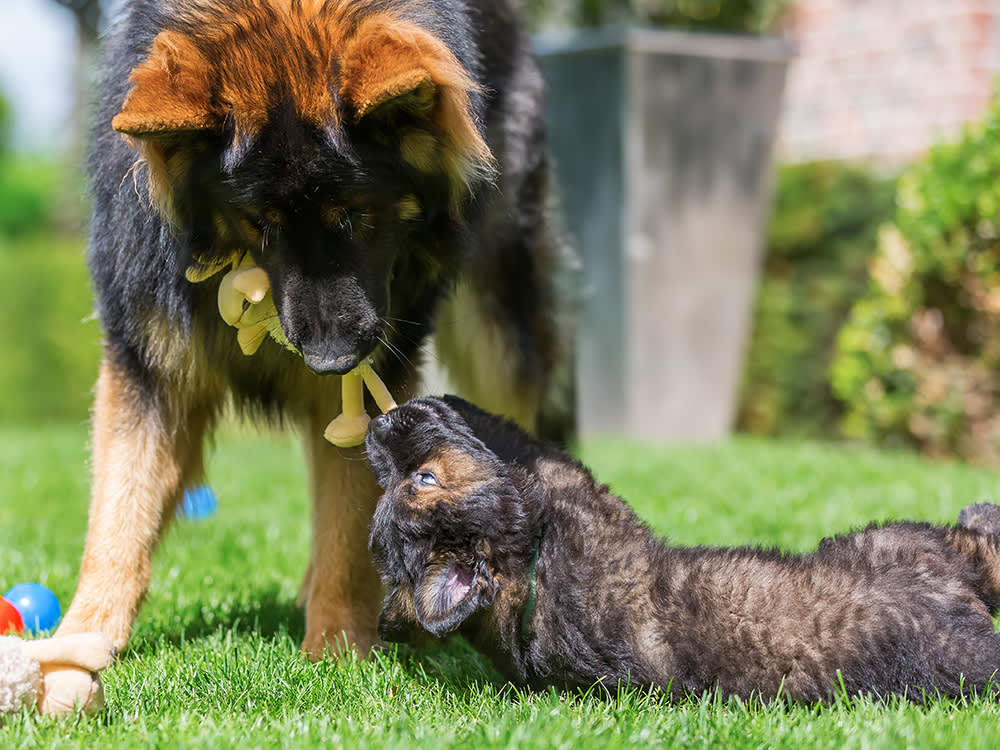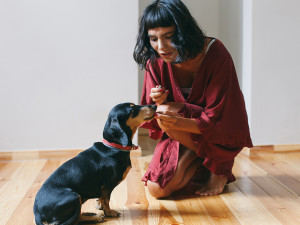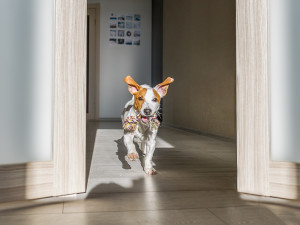Dog Life Stages: Puppy Adolescence Is Only a Phase
Don’t worry; it’s just a phase!

Share Article
The puppy was leaping all over the adult dog — batting the older dog’s ears, crawling across their neck, nudging their muzzle and generally acting like they had no idea that the older dog might prefer to rest after their long play session. It’s the kind of scene I’d heard people describe countless times, but this client had video. As we watched, she said, “See, my older dog was so sweet to my puppy. They could do anything to her and my older pup would just let them.”
But then the story took a turn: “It’s different now. Sometimes they have so much fun, but other times, my older dog growls at my puppy, or even nips their nose,” she told me, clearly bewildered.
In a more recent video, the adult dog was indeed growling and baring their teeth at the exuberant youngster (who had grown significantly) after the younger dog pounced on the older dog’s head. The younger dog immediately stopped and scuttled away. Though the dramatic difference between these two scenes distressed my client, she felt better when I explained that this new development in her dogs’ interactions was completely normal.
The Dynamic Between Adult and Teenage Dogs
Well-socialized, stable, adult dogs typically indulge puppies, allowing them to get away with just about anything. They offer no objection to a young pup who slams into them while they’re resting, walks over them or takes the toy they are playing with.

But when the puppy reaches early adolescence at five or six months, the adult dog will often react differently. This change is not only normal — it’s desirable. There’s no better way for a young dog to learn some manners than to have a socially skilled adult dog set clear boundaries.
As I told my client, the relationship between the adult and the younger dog wasn’t in trouble — rather, it was just that the little guy’s “puppy license” had expired. The older dog was letting the younger dog know that jumping on their head would not be tolerated, and that invitations to play must be offered politely by play-bowing or presenting a toy. Relieved, the woman said that when the puppy did this, the adult dog usually played with them.
Essentially, the puppy had reached the age at which other dogs were inclined to let him know what would and would not be allowed. Humans also do this boundary-setting. When a baby grabs at earrings or pokes an adult in the eye, the adult’s response is minimal. But a seven-year-old who does this is likely to receive instruction on appropriate behavior. Ideally, such instruction is given kindly and fairly to young humans and young dogs alike.
It’s reasonable for an adult dog to warn a puppy with a quick growl or a highly inhibited nip, but not okay for the adult to attack or scare the puppy. Dogs who allow puppies to have their way with them probably have enough self-control to set appropriate limits with an adolescent, and are unlikely to be too rough and overdo it. That said, generalizations aren’t always true, and a young dog should be protected from excessive force, however unexpected. It’s not good for a youngster to be frightened or hurt, even mildly, by an adult dog teaching them manners.
Conversely, it’s not good for that dog to spend tons of time with an adult dog who doesn’t set limits. They never learn that other dogs expect them to behave with more decorum, which means they won’t have opportunities to practice making good choices and inhibiting objectionable behavior. Worse, when they interact with other adult dogs, some may correct them harshly, or even attack them.
Having been told that an adult dog’s behavior is not a problem, the client’s response is often one of relief, followed by the question: “Why didn’t anybody warn me?” It’s a fair question.
The answer is that you probably don’t think about age as having much of an effect on dogs’ behavior. Sure, there are a few exceptions: Most people realize that puppies can’t control their bladders as long as adult dogs (even if house-training is progressing well and the pup seems to grasp the basic idea that the bathroom is outside). It’s also generally accepted that dogs in their golden years tire more easily (so that strenuous, three-hour hike should be reconsidered).
However, the situations in which dogs’ behavior is influenced by their age far outnumber those in which their age is taken into account. This discrepancy creates the possibility of misunderstandings and frustration, which are counterproductive to developing and enjoying a close relationship. In fact, relationships between people and dogs can be tested during adolescence, and it’s no coincidence that dogs are the most vulnerable to being surrendered to shelters and rescues at this stage.
The Dog “Teenage” Phase: What to Expect
Just like human adolescents, dogs can have a mild or extreme experience with their teenage years. As a pet parent, the “teen” period can be a shock, since it comes right on the heels of the adorable-puppy stage. Sure, during a dog’s puppyhood, there are usually some accidents and interrupted sleep, but your puppy’s cuteness largely distracts you from viewing this as a terrible part of dog parenthood. People are rarely blindsided by the trials and tribulations of puppyhood — nobody is surprised by the occasional chewed-up shoe.
Not so in adolescence. This is the time when many of the kindest, most patient dog parents in the world are left wondering where their sweet puppy has gone. There’s an understandable urge to say, “Who is this monster, and what have they done with my dog?”
People are often surprised by the sudden independence of their adolescent dog. The lovable pup who always wanted to be with you and gleefully dashed to your side at the “Come!” cue now seems not to hear you. There’s no reaction — none at all, not even an ear twitch. Sigh. The perfect recall that brought you such pride seems to have disappeared. The same dog who loved to lie down when asked now looks at you as though considering their options: “Hmm, is that really what I want to do right now?” Often, teenage dogs seem to have forgotten everything you worked so hard to teach them.
Don’t panic when you see a training slump in early adolescence; it’s a common, and temporary, phenomenon. The work you’ve put in with your puppy will pay off later. The well-trained, responsive puppy is likely to mature into a well-trained, responsive adult, even if the adolescent in between bears little resemblance to either. As professional baseball player Earl Wilson said, “Snow and adolescence are the only problems that disappear if you ignore them long enough.”
Besides behaving like classic human teenagers, it’s common for adolescent dogs to become more fearful than they were as puppies. At around six to 10 months, some dogs suddenly act timid in situations that they’ve been comfortable with in the past. New people, loud sounds, or going to a new park may cause a dog to hang back, hesitate, or startle.
Mild cases of this “juvenile-onset shyness” are just a phase, and many dogs pass through it no worse for wear. (This is in sharp contrast to dogs who are truly fearful. Dogs don’t simply outgrow this kind of fear, but with knowledge, patience and hard work on their humans’ part, they can overcome it.)
Though many dogs move past juvenile-onset shyness without assistance, it’s wise to be proactive in helping a dog through this challenging period by associating whatever triggers the response with something that the dog loves. For example, if an eight-month-old dog suddenly seems nervous when a man approaches, I would pair that approach with something the dog adores, such as a ball or the best treats ever. This conditioning goes a long way toward preventing shyness from escalating into a deeper fear.
Dog Behavior is Not Static
Many behavioral differences are predictably related to age, with especially big changes occurring during adolescence. They’re easier to handle if you recognize these changes for what they are: a normal part of development. You naturally do this with humans, but often fail to give the same courtesy to dogs. Adult dogs understand the change from puppyhood to adolescence and react accordingly. Perhaps the best course of action is to follow their lead.

Karen B. London, PhD, CAAB, CPDT-KA
Karen B. London is a certified applied animal behaviorist (CAAB) and certified professional dog trainer (CPDT) who specializes in working with dogs with serious behavioral issues, including aggression. She has written for a variety of magazines including The Bark, Clean Run, and the APDT Chronicle of the Dog, and has published in scientific journals including Behavioral Ecology and Sociobiology, Ethology, Ecology, and Evolution, the Journal of Insect Behavior, and Insectes Sociaux. She is the author of seven books about dog training and canine behavior, including the forthcoming My Dog's Mystery Adventure: And Other Stories From a Canine Behaviorist and Dog Trainer.


